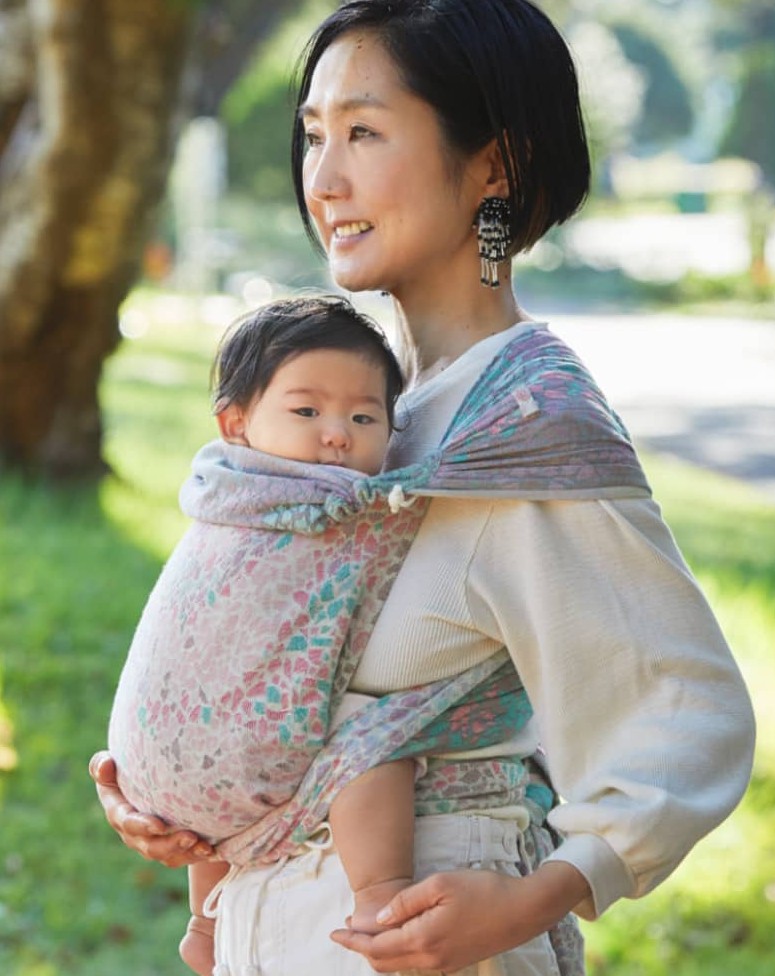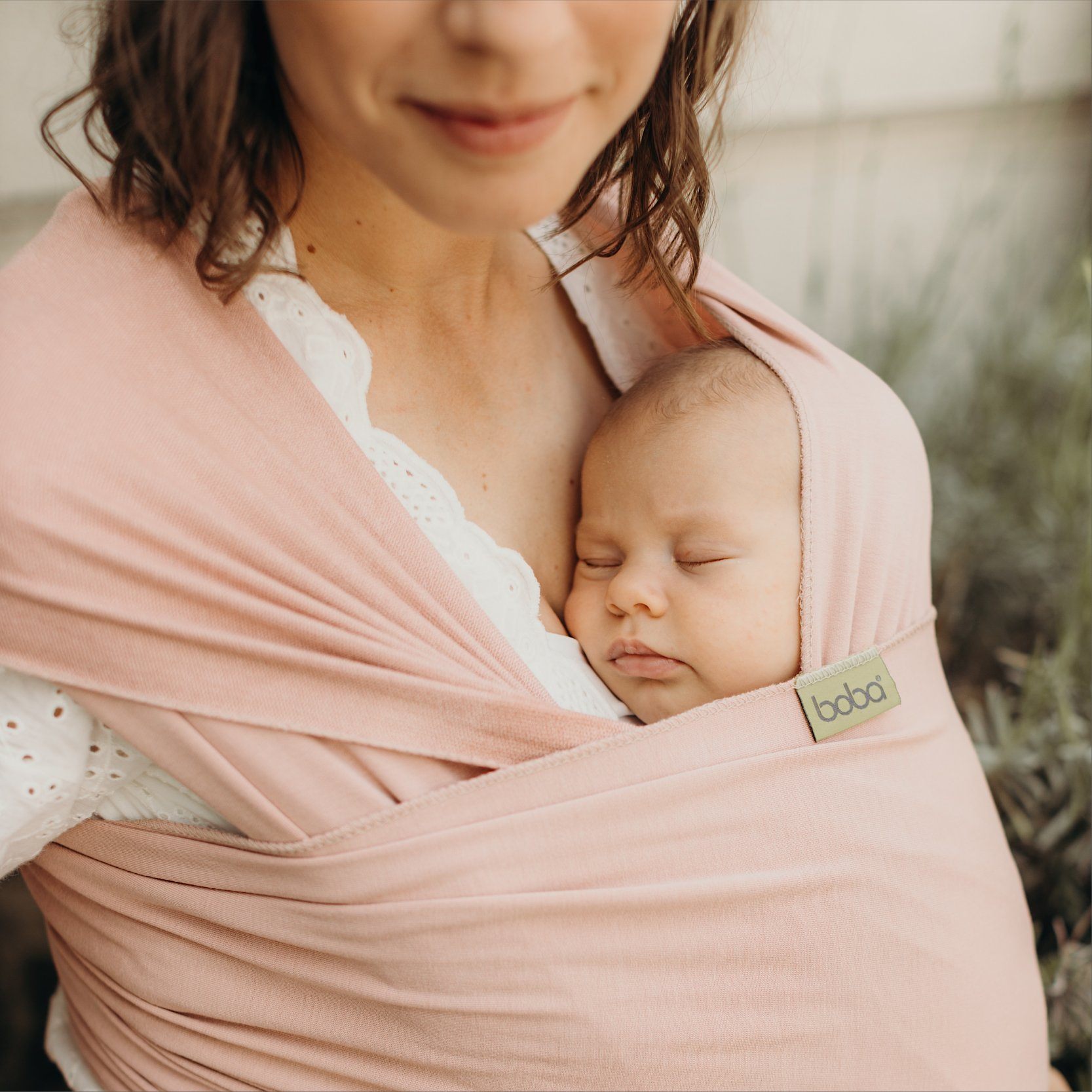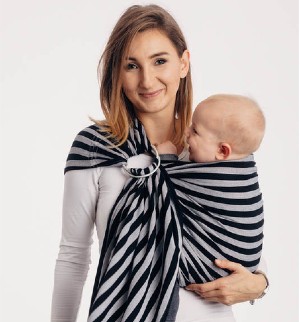There are many different types of baby carriers!
Some are very simple cloth carriers, the type that have been used in different cultures throughout history. Through to the other end of the spectrum, with loads of features and a squillion buckles...
Which carrier is right for you and your baby? Different carriers suit different adults, much like different jeans fit different people. Different carrier styles better suit the age of your child, how often you'll be wearing it and what you'll be using it for. And don't forget to consider what you like the look of - choosing a carrier you love the look of means you'll be much more likely to use it.
Here's the common types of carriers and some others to consider:
Ergonomic Soft structured carrier
 These are the most common carriers in New Zealand. They are what a lot of people consider a 'baby carrier' and what you'll see a lot of families using when you're out and about.
These are the most common carriers in New Zealand. They are what a lot of people consider a 'baby carrier' and what you'll see a lot of families using when you're out and about.
Basically a soft structured carrier has a soft fabric body panel and straps that attach with buckles - two shoulder straps and a waist band that closes with a big buckle. Generally the straps and waist band are padded for comfort, though carriers with an unstructured waist (no padding) can be excellent for compact travel carriers and also for adults with a very slim waist or short torso.
All soft structured carriers can be worn on the front and back. Some models can be worn facing outwards. Some buckle carriers may be able to be used on the hip as well, though this depends on the shape of the shoulder straps. Hip carrrying with a buckle carrier is generally not a great option as the strap can rub on the neck - see ring slings or meh dai for a better hip option.
Many carriers are adjustable for a range of ages, others are size specific or need an infant insert to use with a newborn. Soft structured or buckle carriers offer great value over the long term as they can often be worn from baby through to toddlerhood.
However do consider when you'll be mostly using the carrier, particularly if you are wanting to use it from newborn. If you choose a 'one carrier for all time' option, there will be a compromise somewhere. Likely it will be bulky and not so comfy for the very frequent carrying you'll do in the first few weeks and months. For most families, having a wrap or sling as well as a soft structured carrier gives the best combination of comfort, value and practicality without needing to compromise too much.
Look into how the carrier adjusts for different sizes - is it simple to use? Does it genuinely cover the size you want the carrier for?
These carriers generally offer a healthy hip position, where your baby's knees are higher than their bottom so their hips are well supported in the best position. You may still need to tweak the fit by doing a pelvic tilt, see you FAQ on this.
Soft structured carriers are simple to use and usually quite comfortable for both you and your child. However you may want to try on several options to get the best fit for you, especially if you'll be using it often or will be carrying for longer periods of time.
Note there is no safety standard for buckle carriers in New Zealand. we recommend you choose one that meets either the EU or US safety standard.
Please note there are a lot of fake branded carriers sold in New Zealand on Marketplace, TradeMe etc. If you are buying a soft structured carrier of a well known brand, the prices are reasonably consistent across retailers. if the price is too good to be true, then it is likely a fake. Buy from reputable retailers or ask for proof of purchase if buying second hand.
Meh Dai & Half Buckles
 This style of carrier is based on the traditional Chinese style of carrier, that has been used to carry babies through the ages. Traditionally these carriers would have been made by family members and a new one would have been made as baby grew. They are super simple and intuitive to use.
This style of carrier is based on the traditional Chinese style of carrier, that has been used to carry babies through the ages. Traditionally these carriers would have been made by family members and a new one would have been made as baby grew. They are super simple and intuitive to use.
A Meh Dai has a similar shape to a soft structured carrier with a back panel, shoulder straps and waist straps. The main difference with a Meh Dai a is that the straps tie rather than close with buckles.
Meh Dai are an excellent option for using with adults of different sizes as you can tie them to which ever size that you need.
They can be worn with your baby facing inwards, on the hip or on the back.
Some Meh Dai have adjustable panel width and height, so you can easily adjust them for a smaller baby. However they are also very simple to adjust yourself, by either rolling over the waist to shorten the panel and then squish in the sides of the panel to make the base a bit narrower for a little baby. You can also easily 'cinch' the base narrower with something like a shoe lace.
Meh Dai can be tied in different ways and the straps can be used to provide more support under the legs as babies get bigger.
There are 2 main types of Meh Dai - Simple and Wrap Strap. The Simple style of Meh Dai are just that - very easy to use, lightly padded shoulder straps and not a lot of bulk or ways to adjust them apart from the ways mentioned above. Woven Wrap strap Meh Dai are beautiful and super soft, but the width and length of the straps can be a bit overwhelming for new users. They often now have height and width adjustment to try and market them as one size fits all...but this can means a lot more fabric and carrier than you need for a newborn!
Meh Dai are often just one layer of fabric, so these can be a very cool option for summer.
They may have a hood or small neck support. Hoods are intended for use when back-carrying to provide more support from sleepy heads lolling around rather than covering baby's face on the front.
There are also 'Half Buckle' carriers, with buckle waist and tie strap - these are one of the most versatile and comfortable carriers you can find! Not many brands make a Half Buckle but we recommend hunting these excellent carriers out with a specialist retailer or babywearing consultant.
 Stretchy Wraps
Stretchy Wraps
These are a very popular option for carrying newborns, as they are super comfortable and can be left on all day. It's easy to pop baby in and out, and just leave the wrap tied on.
Stretchy fabric wraps are suitable for front carrying for around 6-9 months and can be worn by any sized adult. They come in various fabrics, the ones with a little elastane (2-way stretch) are easier to tie securely and much easier to get baby in and out of without loosening the wrap.
Stretchy wraps are easy to learn to use. The key things are tying it very snuggly, making sure all 3 layers of fabric are over baby and that baby's airways are not covered. Wearing the wrap high on the firm part of your chest (close enough to kiss) is a good rule of thumb.
These are a low-priced, one size fits all babies and adults option.
Ring Sling

A ring sling is a simple fabric carrier that is adjusted and secured by 2 metal rings. The fabric sits over one shoulder, a hammock style seat is made for baby and the fabric pulled up to the top of baby's neck. The sling is tightened by pulling the fabric through the rings.
A sling can be used on the front or hip, from newborn to toddler and beyond.
They are a lovely option for newborns as they are not bulky or padded, and are easy to get baby up into a high, snug fit on your chest (as you would carry a newborn in your arms).
Slings should only be worn in the upright position. Older style slings may have suggested using the lying down (creadel) position however this is generally now considered unsafe as it is harder to monitor baby's airways and baby's chin can end up on the chest, cutting off their airway.
Ring Slings can take a little practice to get the threading and tightening feeling right, you may find some help from a babywearing group or consultant helpful.
Slings are also an ideal option for travel or occasional quick carries with toddlers, as they are the most compact carrier option.
Given they are a one-size-fits-all for both babies and adults, they are a very cost effective carrier choice.
 Long Woven Wrap
Long Woven Wrap
Long Woven Wraps are a beautiful and versatile baby carrying option.
They can be used from newborn right through until you stop carrying. The fabric is specially woven to be comfortable, strong and be able to be tied securely. Wrappers often have a strong preference for the type of fabric used and the weight of the fabric, but a 100% cotton lighter weight wrap is usually considered the easiest to learn with.
Wrapping with a long wrap may be seen as difficult or complicated, however the most simple 'front wrap cross carry' is surprisingly easy to learn from your local babywearing group or consultant, or see our recommended babywearig resources for great You Tube tutorials. The key is taking your time and learning to tighten the fabric to ensure that baby is well supported and you are both comfortable.
Wraps can give you a lot of versatility in the wrap you carry, they can be worn on the front, hip and back. Wraps can also give you a very comfortable and ergonomic position for baby or older child.
They come in a range of sizes with a 4.6cm (size 6) or 5.2cm (size 7) are the most common. The size to use depends a both the adult size and also the type of carry that you use the wrap for.
Wraps come in a wide price range, including lots available second hand in New Zealand and local specialist retailers selling a number of lovely brands.
Short Fabric Wrap
A 'shortie' wrap is commonly 2.7m long and called a size 2 wrap. These are a very versatile carrier that can be used on the front, hip or back. There are also size1, 3 & 4 wraps which may suit different carries better depending on what you want to do and your size.
The easiest carry to learn with a short wrap is a slip-knot hip carry, which is basically like a ring sling without the rings.
A short wrap is an excellent option for an occsional carrier, as it's quick to tie, compact to carry and can double as a blanket or something to sit on as needed!
Generally shortie wraps are made from special 'woven wrap' fabric and sourced from specialist sling retailers or bought second hand.
A size 2 wrap would fit pretty much all sizes of children and adults for simple carries so makes a very good value option.
Front pack
The term ‘front pack’ refers to the older non-ergonomic carrier style with straps over both shoulders, 2 leg holes and a crotch piece to support the baby. Baby can be worn in the facing-inwards position, and some models offer facing outwards. These carriers are suitable for the early weeks provided baby does not have hip dysplasia or loose hips (remember up to 15% of hip prpblems are never diagnosed). However these carriers do not provide sufficient comfort as the baby grows or ergonomic support for parents. Parents should be aware that many carriers in this category are not recommended by babywearing educators due to the lack of hip support given the number of babies where hip issues are never picked up.

